Amateur Astronomy
David P. Anderson
We have a couple of telescopes and a great pair of
Celestron binoculars and an
occasional interest in star gazing, mostly on our spring and summer vacations to
New Mexico and Colorado, where the skies are exceptionally dark. Our first telescope
was a borrowed 8 inch f10 Newtonian reflector, which we set up in our back yard for
a year. After that we bought a 60mm f10 refractor as a birthday present for my wife.
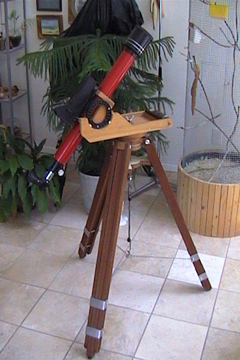
We made a number of changes to the refractor. We added 26mm and 32mm eyepieces and
a 1.25 inch right angle adapter to
complement the 20mm eyepiece that came with the telescope. We removed the finder-scope and
replaced it with a
Telrad reflex sight.
This made the telescope much easier
to use. After about a year we decided that the tripod that came with the scope was
just too awkward and the adjustments too clumsy. So we built our own
Dobson style
refractor tripod, pictured above and below.
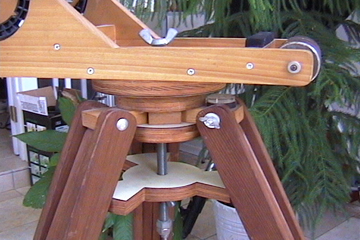
The tripod itself is made of redwood with a formica-and-plywood spreader, and extensible legs.
The Dobson mount utilizes teflon pads riding on a formica surface for the azimuth rotations,
and hard plastic rings riding on teflon pads for the altitude rotations. This combination
produces an extremely smooth "buttery" feeling mount which is very easy to use. The telescope
is balanced and requires no locking screws to hold it in any given position. The plastic and
teflon bearings produce very low friction and, more importantly, the static and dynamic friction
are nearly equal so that moving the telescope by tiny amounts is easily accomplished, without
bumping it out of position.
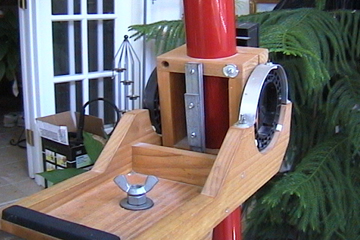
The Telrad reflex site and right angle prism are counterbalanced on the bottom of
the box which holds the telescope. The telescope itself is mounted cantilever fashion off
center from the mount so that it can be pointed straight up at the zenith without interfering
with the tripod legs. The whole thing is then counterbalanced with three lead weights mounted
in the front of the Dobson base between the left and right side members. A piece of black
industrial foam rubber pads the front of the telescope tube when it is in the horizontal position.
The telescope, tripod and all, only weights about 15 pounds and can be easily carried out in
the backyard for casual observing, when we don't feel like setting up the "big" telescope.
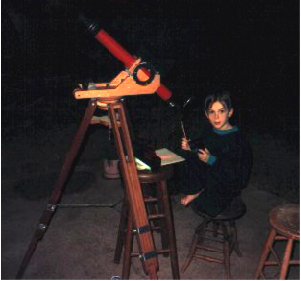
Here is a very young Jonathan stargazing in his pajamas with his red flash-light (so as not
to disturb dark-adjusted eyes) and his observing notebook, sketching the craters of the moon.
The combination of the reflex site and low-friction Dobson mount makes for a very intuitive
telescope that the kids greatly enjoy using. (Sometimes I think it also does duty as some kind of
Star Wars laser weapon.)
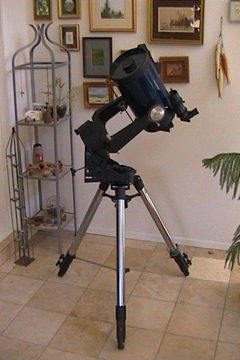
Our other telescope is a
Meade 8 inch
Schmidt-Cassegrain. This telescope has an
f10 focal length
in a folded optical path making the telescope tube only about a foot long. It is suspended on a
pair of aluminum forks with a motor drive, attached to an adjustable equtorial wedge, all bolted
to a massive steel tripod. We have several eyepieces for it, including 10mm, 18mm, 26mm, 32mm,
and and enormous 36mm wide angle "Erfle" eyepiece which requires a special 2 inch right angle
adapter. Views of faint deep space objects like nebula and galaxies, barely visible in the
60mm refractor, are breathtaking. We added another Telrad reflex finder in addition
to the finder scope, both of which are usually needed for locating faint objects and star-hopping.
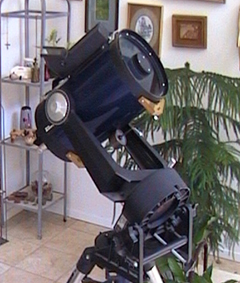
The bar and lead weight underneath the tube body are used to counterbalance the finder-scope,
Telrad, and a 35mm camera we sometimes mount on top of the 'scope for time-exposure photography.
This 'scope is much heavier and requires considerably more attention to setup, polar align,
and so on, but produces much sharper and brighter views than the refractor, which is more useful
for lunar and planetary observing. We have over the years added a set of 35mm cameras and adapters
for photography which the motor drive and careful alignment (and hand guiding) make possible.
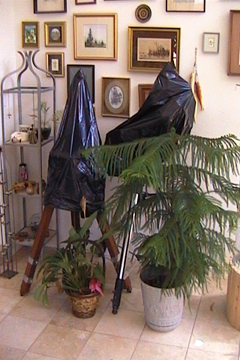
Increase in light pollution over the past ten years in our neighborhood has made observing more
difficult. This especially contrasts with the dark skys we see in New Mexico and Colorado, and
the superb viewing experiences we have had in the Davis Mountains near Ft. Davis (home to the
MacDonald Observatory and
"Texas Star Party"). Most of the time
both telescopes spend their days and nights shrouded in their plastic bags to protect them from
dust and the ever-present bird feathers from my wife's 17 finches, parakeets, and doves.
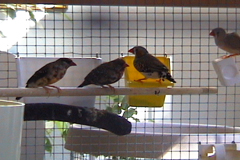
24 August 2002
Dallas, Texas
dpa
Back to my personal stuff homepage.








